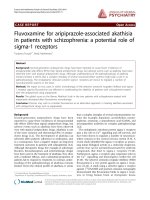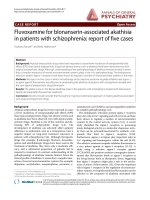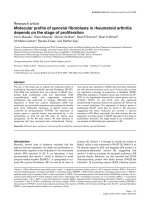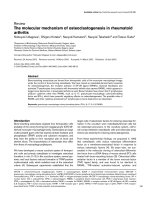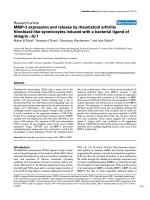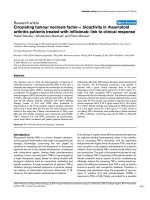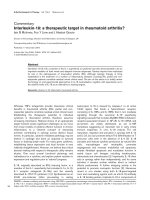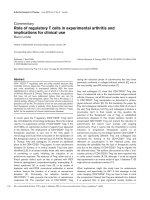Báo cáo y học: "Evidence for early disease-modifying drugs in rheumatoid arthritis" pps
Bạn đang xem bản rút gọn của tài liệu. Xem và tải ngay bản đầy đủ của tài liệu tại đây (43.91 KB, 4 trang )
15
anti-TNF = antitumour necrosis factor; ASPIRE = Active Controlled Study of Patients Receiving Infliximab for Treatment of Rheumatoid Arthritis of
Early Onset; COBRA = Combinatietherapie Bij Reumatoide Artritis; DMARD = disease modifying antirheumatic drug; FIN-RACo = Finnish
Rheumatoid Arthritis Combination; NSAID = nonsteroidal anti-inflammatory drug; RA = rheumatoid arthritis; RCT = randomised controlled trial.
Available online />Introduction
The optimal treatment for early rheumatoid arthritis (RA)
remains the subject of intense debate. There are many
options. There is some support for aggressive treatment by
immediately starting combination therapy with two or more
disease-modifying antirheumatic drugs (DMARDs) plus
steroids, or even with DMARDs plus antitumour necrosis
factor (anti-TNF). The most conservative alternative involves
initially using nonsteroidal anti-inflammatory drugs
(NSAIDs), only starting DMARD monotherapy if this proves
insufficient. The value of this latter therapeutic pyramid has
been questioned for many years [1]. Current opinion favours
early DMARD therapy [2]. A recent report by Verstappen
and colleagues [3] focused attention on the complexities in
evaluating whether to abandon the pyramidal approach to
treatment and to focus on starting DMARDs early.
Observational studies provide an opportunity to explore the
benefits of early DMARDs. The Norfolk Arthritis Register, a
large observational study in early arthritis, enrols cases of
early polyarthritis from one area of England. A recent report
from the register evaluated DMARD therapy in 353 con-
secutive RA patients followed for 5 years [4]. As patients
with mild arthritis inevitably have good outcomes without
DMARDs, statistical adjustment was essential to control for
disease severity. Although patients who received DMARDs
had more radiographic progression, this was related to
their high initial disease severity. After adjusting for base-
line severity, early DMARD therapy in severe RA gave the
most beneficial outcomes at 5 years.
Evidence from randomised controlled trials (RCTs) sup-
ports these observational findings. Early treatment with
Commentary
Evidence for early disease-modifying drugs in rheumatoid
arthritis
David L Scott
Department of Rheumatology, Kings College Hospital, London, UK
Corresponding author: David L Scott (e-mail: )
Received: 6 Oct 2003 Accepted: 6 Nov 2003 Published: 16 Dec 2003
Arthritis Res Ther 2004, 6:15-18 (DOI 10.1186/ar1030)
© 2004 BioMed Central Ltd (Print ISSN 1478-6354; Online ISSN 1478-6362)
Abstract
Some research evidence supports early aggressive treatment of rheumatoid arthritis (RA) using
combination therapy with two or more disease modifying anti-rheumatic drugs (DMARDs) plus
steroids, or even DMARDs plus an anti-TNF. By contrast, conservatively delayed DMARD
monotherapy, given after non-steroidal anti-inflammatory drugs have failed, has been criticised.
However, recent long-term studies highlight the complexities in evaluating whether to abandon
pyramidal treatment in favour of early DMARDs. Although patients given early DMARD therapy show
short-term benefits, longer-term results show no prolonged clinical advantages from early DMARDs. By
5 years patients receiving early DMARDs had similar disease activity and comparable health
assessment questionnaire scores to patients who received DMARDs later in their disease course.
X-ray progression was persistent and virtually identical in both groups. These negative findings do not
invalidate the case for early DMARD therapy, as it is gives sustained reductions in disease activity in
the early years of treatment without excessive risks from adverse effects. However, early DMARDs
alone do not adequately control RA in the longer term. This may require starting with very aggressive
therapy or treating patients more aggressively after early DMARD therapy has been initiated.
16
Arthritis Research & Therapy Vol 6 No 1 Scott
sulphasalazine reduces disease activity and X-ray progres-
sion over 12 months compared with persisting with
NSAIDs alone [5]. As a relatively potent DMARD, sul-
phasalazine is also more effective than a ‘weaker’ DMARD
such as hydroxychloroquine in limiting the X-ray progres-
sion in early RA [6]. Benefits from early DMARD therapy
extend over 5 years. Borg and colleagues [7] compared
early treatment with a weak DMARD (auranofin) against a
wait-and-see policy in 137 patients with early RA. After
2 years there was convincing evidence favouring early
DMARD therapy. A subsequent review of 75 of these
patients after 5 years [8] showed continuing benefits from
early DMARD therapy on clinical and radiological out-
comes. A comparable study [9] evaluated 104 of 119
patients who had participated in a 9-month RCT of hydrox-
ychloroquine versus placebo in early RA. Three years after
the study ended, early DMARD therapy still resulted in
less pain and disability.
The report by Verstappen and colleagues [3] shows that
the situation is very complex. The report outlined 5-year
follow-up results from an earlier trial involving 238 patients
with recently diagnosed RA. The minority of cases had
been randomised to pyramid treatment, receiving NSAIDs
for at least 12 months and waiting an average of
14 months before starting DMARDs. The majority were
randomised to receive early DMARDs. Five-year results in
44 patients given pyramid treatment and in 145 patients
given early DMARDs, however, showed no prolonged clin-
ical advantages from early DMARDs. In the first 12 months
there had been many advantages from early DMARDs;
most clinical variables showed better responses. These
benefits were reported in an initial paper [10], which pro-
vided strong support for early DMARD therapy. Neverthe-
less, the benefits of early DMARDs became less obvious
with time. By 5 years patients receiving early DMARDs
had similar disease activity and comparable health assess-
ment questionnaire scores with patients who received
DMARDs later in their disease course. X-ray progression
was persistent and virtually identical in both groups.
Such negative results do not weaken the case for early
DMARD therapy. Patients receiving early DMARDs bene-
fited from sustained reductions in disease activity in the
early years of treatment without excessive risks from
adverse effects. However, early DMARDs alone do not
adequately control RA in the longer term. Two alternative
strategies may be needed. First, starting with more aggres-
sive therapy and, second, treating patients more aggres-
sively after early DMARD therapy has been initiated.
More aggressive initial therapy may involve adding low-
dose steroids, using combination DMARDs and the early
use of biologics. The early use of low-dose steroids is very
controversial. Two RCTs have addressed this question.
The Arthritis Research Council steroid study [11] showed
that adding low-dose steroids to DMARDs reduced the
subsequent X-ray progression. van Everdingen and col-
leagues [12] enrolled 81 patients with early active RA who
had not been treated with DMARDs. Patients received
10 mg/day oral prednisone or placebo. After 6 months sul-
phasalazine could be prescribed as rescue medication.
Radiological scores after 6 months showed significantly
less progression with prednisone compared with placebo
without major side effects from steroids.
Although such benefits from low-dose steroids meant that
some experts believe they should become standard treat-
ment [13], other experts disagree [14]. The issue is made
more complex by the potential role of high-dose step-
down steroid therapy used in combination studies (dis-
cussed later). Interestingly, an analysis of the
cost-effectiveness of low-dose steroids in RA concluded
that their use was economically favourable [15].
The next question is whether to use one DMARD or
several DMARDs in early RA. The COBRA (Combinati-
etherapie Bij Reumatoide Artritis) study [16] compared
sulphasalazine monotherapy with the combination of sul-
phasalazine, methotrexate and prednisolone (tapered from
60 mg/day to 7.5 mg/day over 9 months and then
stopped) in 155 patients with early RA. By 6 months 72%
of patients on combination therapy had ACR-20
responses compared with 49% of patients on monother-
apy, and median X-ray damage had increased by 1 Sharp
unit with combined therapy and by 4 Sharp units with
monotherapy. Five years later the benefits of combination
therapy on joint damage persisted [17]. After adjusting for
treatment and disease activity during follow-up, the
between-group difference in radiological progression
(3.7 points/year) still favoured combination therapy. Eco-
nomic analysis also showed that the COBRA study was
cost-effective [18].
Another RCT, the FIN-RACo (Finnish Rheumatoid Arthritis
Combination) trial, also favoured combination therapy in
early RA [19]. It compared combination therapy (sul-
phasalazine, methotrexate, hydroxychloroquine and pred-
nisolone) with DMARD monotherapy (with or without
prednisolone) in 199 patients over 2 years. At 12 months,
24 of 97 patients achieved remission with combination
therapy but only 11 of 98 patients achieved remission with
monotherapy. Remission remained more frequent with
combination therapy at 2 years. Subsequent analyses
found that delaying DMARD therapy by only a few months
decreased the ability of the monotherapy to induce remis-
sion [20]. The benefits of combination therapy were unaf-
fected by delay.
Not all trials of early combination DMARDs are positive.
Haagsma and colleagues [21] found that combination
therapy was no more effective than monotherapy with sul-
17
phasalazine or methotrexate in 105 patients with early RA.
Dougados and colleagues [22] also found no benefit from
combining methotrexate and sulphasalazine in
205 patients with active RA. A 5-year review of these
cases also showed no benefits from combination
DMARDs [23]. RCTs with cyclosporin as part of a
DMARD combination in early RA have also given equivo-
cal [24] or negative [25] results, although these latter
studies were relatively small.
The final approach to early aggressive treatment is to use
biologics. The only published evidence for biologics is
from the early RA trial of etanercept, which showed that
this biologic is more effective than methotrexate over
2 years in reducing X-ray progression and in controlling
symptoms [26]. More impressive results are likely from
combining anti-TNF therapy with methotrexate. Unpub-
lished data from a RCT combining infliximab with
methotrexate, presented at the European League Against
Rheumatism congress (the ASPIRE [Active Controlled
Study of Patients Receiving Infliximab for Treatment of
Rheumatoid Arthritis of Early Onset] trial), strongly sug-
gests this will be the case. Preliminary data from the
ASPIRE trial indicate that patients treated with infliximab
plus methotrexate had no X-ray progression and had
markedly less disability than patients receiving methotrex-
ate monotherapy.
There is similar unpublished data with other anti-TNF
drugs. The implication is that excellent short-term out-
comes can be achieved by treating all early RA patients
with a combination of methotrexate and anti-TNF.
However, before introducing such a policy in routine prac-
tice, several questions need to be addressed. The short-
term benefits of combination therapy with biologics may
not last and, as with the report from Verstappen and col-
leagues [3], initial good results may not give long-term
benefits. Another problem is that many patients with early
RA may not need aggressive treatment. Observational
studies and RCTs in early RA invariably identify cohorts of
patients with mild disease that respond well to NSAIDs
alone. The blanket use of DMARD/biologic combinations
would expose such mild cases to prolonged courses of
highly active drugs. An added difficulty is the high cost of
biologics, which may mean that their widespread use
cannot be economically justified.
An alternative assessment of the results reported by Ver-
stappen and colleagues [3] is that early DMARDs are
useful in the short term, but that in the medium term more
aggressive treatment is needed in some patients. There is
a relative dearth of information on this issue, although one
RCT (Tight Control of Rheumatoid Arthritis, C Grigor and
colleagues) presented at The British Society for Rheuma-
tology meeting, 2003, and not yet published suggests that
adding DMARDs sequentially to obtain tight control of RA
is practical and effective. It seems most logical to treat
some patients with early RA with NSAIDs alone, to treat
some patients with DMARD monotherapy, to treat some
patients with DMARD combination therapy and to treat
some patients with DMARDs and biologics. Although treat-
ing all patients with DMARDs and biologics may seem
better than other choices over 12–24 months, the gradual
addition of drugs in an organised manner over 5 years may
be equally clinically effective and will be substantially more
cost-effective. Providing answers to such complex ques-
tions will take many years, and it is likely to remain an area
of research endeavour for the foreseeable future.
Competing interests
None declared.
References
1. Wilske KR, Healey LA: Remodeling the pyramid: a concept
whose time has come. J Rheumatol 1989, 16:565-567.
2. Quinn MA, Conaghan PG, Emery P: The therapeutic approach
of early intervention for rheumatoid arthritis: what is the evi-
dence? Rheumatology 2001, 40:1211-1220.
3. Verstappen SM, Jacobs JW, Bijlsma JW, Heurkens A, van Booma-
Frankfort C, Borg EJ, Hofman DM, van der Veen MJ: Utrecht
Arthritis Cohort Study Group. Five-year followup of rheuma-
toid arthritis patients after early treatment with disease-modi-
fying antirheumatic drugs versus treatment according to the
pyramid approach in the first year. Arthritis Rheum 2003, 48:
1797-1807.
4. Bukhari MA, Wiles NJ, Lunt M, Harrison BJ, Scott DG, Symmons
DP, Silman AJ: Influence of disease-modifying therapy on radi-
ographic outcome in inflammatory polyarthritis at five years:
results from a large observational inception study. Arthritis
Rheum 2003, 48:46-53.
5. Choy EH, Scott DL, Kingsley GH, Williams P, Wojtulewski J,
Papasavvas G, Henderson E, Macfarlane D, Erhardt C, Young A,
Plant MJ, Panayi GS: Treating rheumatoid arthritis early with
disease modifying drugs reduces joint damage: a randomised
double blind trial of sulphasalazine vs diclofenac sodium. Clin
Exp Rheumatol 2002, 20:351-358.
6. van der Heijde DM, van Riel PL, Nuver-Zwart IH, Gribnau FW, vad
de Putte LB: Effects of hydroxychloroquine and sul-
phasalazine on progression of joint damage in rheumatoid
arthritis. Lancet 1989, 1:1036-1038.
7. Borg G, Allander E, Berg E, Brodin U, From A, Trang L: Auranofin
treatment in early rheumatoid arthritis may postpone early
retirement. Results from a 2-year double blind trial. J Rheuma-
tol 1991, 18:1015-1020.
8. Egsmose C, Lund B, Borg G, Pettersson H, Berg E, Brodin U,
Trang L: Patients with early arthritis benefit from early 2nd line
therapy: 5 year follow-up of a prospective double blind
placebo controlled study. J Rheumatol 1995, 22:2208-2213.
9. Tsakonas E, Fitzgerald AA, Fitzcharles MA, Cividino A, Thorne JC,
M’Seffar A, Joseph L, Bombardier C, Esdaile JM: Consequences of
delayed therapy with second-line agents in rheumatoid arthritis:
a 3 year followup on the hydroxychloroquine in early rheumatoid
arthritis (HERA) study. J Rheumatol 2000 27:623-629.
10. Van der Heide A, Jacobs JW, Bijlsma JW, Heurkens AH, Booma-
Frankfort C, van der Veen MJ, Haanen HC, Hofman DM, van
Albada-Kuipers GA, ter Borg EJ, Brus HL, Dinant HJ, Kruize AA,
Schenk Y: The effectiveness of early treatment with ‘second-
line’ antirheumatic drugs: a randomized, controlled trial. Ann
Intern Med 1996, 124:699-707.
11. Kirwan JR: The effect of glucocorticoids on joint destruction in
rheumatoid arthritis. The ARC Low Dose Glucocorticoid Study
Group. N Engl J Med 1995, 333:142-146.
12. van Everdingen AA, Jacobs JW, Siewertsz Van Reesema DR,
Bijlsma JW: Low-dose prednisone therapy for patients with
early active rheumatoid arthritis: clinical efficacy, disease-modi-
fying properties, and side effects: a randomized, double-blind,
placebo-controlled clinical trial. Ann Intern Med 2002, 136:1-12.
Available online />18
13. Conn DL: Resolved: low-dose prednisone is indicated as a
standard treatment in patients with rheumatoid arthritis.
Arthritis Rheum 2001, 45:462-467.
14. Saag KG: Resolved: low-dose glucocorticoids are neither safe
nor effective for the long-term treatment of rheumatoid arthri-
tis. Arthritis Rheum 2001, 45:468-471.
15. Bae SC, Corzillius M, Kuntz KM, Liang MH: Cost-effectiveness
of low dose corticosteroids versus non-steroidal anti-inflam-
matory drugs and COX-2 specific inhibitors in the long-term
treatment of rheumatoid arthritis. Rheumatology 2003, 42:46-
53.
16. Boers M, Verhoeven AC, Markusse HM, van de Laar MA, West-
hovens R, van Denderen JC, van Zeben D, Dijkmans BA, Peeters
AJ, Jacobs P, van den Brink HR, Schouten HJ, van der Heijde DM,
Boonen A, van der Linden S: Randomised comparison of com-
bined step-down prednisolone, methotrexate and sul-
phasalazine with sulphasalazine alone in early rheumatoid
arthritis. Lancet 1997, 350:309-318.
17. Landewe RB, Boers M, Verhoeven AC, Westhovens R, van de
Laar MA, Markusse HM, van Denderen JC, Westedt ML, Peeters
AJ, Dijkmans BA, Jacobs P, Boonen A, van der Heijde DM, van
der Linden S: COBRA combination therapy in patients with
early rheumatoid arthritis: long-term structural benefits of a
brief intervention. Arthritis Rheum 2002, 46:347-356.
18. Verhoeven AC, Bibo JC, Boers M, Engel GL, van der Linden S:
Cost-effectiveness and cost-utility of combination therapy in
early rheumatoid arthritis: randomized comparison of com-
bined step-down prednisolone, methotrexate and sul-
phasalazine with sulphasalazine alone. COBRA Trial Group.
Combinatietherapie Bij Reumatoide Artritis. Br J Rheumatol
1998, 37:1102-1109.
19. Mottonen T, Hannonen P, Leirisalo-Repo M, Nissila M, Kautiainen
H, Korpela M, Laasonen L, Julkunen H, Luukkainen R, Vuori K,
Paimela L, Blafield H, Hakala M, Ilva K, Yli-Kerttula U, Puolakka K,
Jarvinen P, Hakola M, Piirainen H, Ahonen J, Palvimaki I, Forsberg
S, Koota K, Friman C: Comparison of combination therapy with
single-drug therapy in early rheumatoid arthritis: a ran-
domised trial. FIN-RACo trial group. Lancet 1999, 353:1568-
1573.
20. Mottonen T, Hannonen P, Korpela M, Nissila M, Kautiainen H,
Ilonen J, Laasonen L, Kaipiainen-Seppanen O, Franzen P, Helve T,
Koski J, Gripenberg-Gahmberg M, Myllykangas-Luosujarvi R,
Leirisalo-Repo M, Finnish Rheumatoid Arthritis Combination
Therapy Trial Group: Delay to institution of therapy and induc-
tion of remission using single-drug or combination-disease-
modifying antirheumatic drug therapy in early rheumatoid
arthritis. Arthritis Rheum 2002, 46:894-898.
21. Haagsma CJ, van Riel PL, de Jong AJ, van de Putte LB: Combina-
tion of sulphasalazine and methotrexate versus the single
components in early rheumatoid arthritis: a randomized, con-
trolled, double-blind, 52 week clinical trial. Br J Rheumatol
1997, 36:1082-1088.
22. Dougados M, Combe B, Cantagrel A, Goupille P, Olive P, Schat-
tenkirchner M, Meusser S, Paimela L, Rau R, Zeidler H, Leirisalo-
Repo M, Peldan K: Combination therapy in early rheumatoid
arthritis: a randomised, controlled, double blind 52 week clini-
cal trial of sulphasalazine and methotrexate compared with
the single components. Ann Rheum Dis 1999, 58:220-225.
23. Maillefert JF, Combe B, Goupille P, Cantagrel A, Dougados M:
Long term structural effects of combination therapy in
patients with early rheumatoid arthritis: five year follow up of
a prospective double blind controlled study. Ann Rheum Dis
2003, 62:764-766.
24. van den Borne BE, Landewe RB, Goei The HS, Rietveld JH, Zwin-
derman AH, Bruyn GA, Breedveld FC, Dijkmans BA: Combina-
tion therapy in recent onset rheumatoid arthritis: a
randomized double blind trial of the addition of low dose
cyclosporine to patients treated with low dose chloroquine.
J Rheumatol 1998, 25:1493-1498.
25. Proudman SM, Conaghan PG, Richardson C, Griffiths B, Green
MJ, McGonagle D, Wakefield RJ, Reece RJ, Miles S, Adebajo A,
Gough A, Helliwell P, Martin M, Huston G, Pease C, Veale DJ,
Isaacs J, van der Heijde DM, Emery P: Treatment of poor-prog-
nosis early rheumatoid arthritis. A randomized study of treat-
ment with methotrexate, cyclosporin A, and intraarticular
corticosteroids compared with sulfasalazine alone. Arthritis
Rheum 2000, 43:1809-1819.
26. Genovese MC, Bathon JM, Martin RW, Fleischmann RM, Tesser
JR, Schiff MH, Keystone EC, Wasko MC, Moreland LW, Weaver
AL, Markenson J, Cannon GW, Spencer-Green G, Finck BK:
Etanercept versus methotrexate in patients with early
rheumatoid arthritis: two-year radiographic and clinical out-
comes. Arthritis Rheum 2002, 46:1443-1450.
Correspondence
David L Scott, Department of Rheumatology, Kings College Hospital,
Denmark Hill, London SE5 9RS, UK. Tel: +44 (0)20 7346 1731; fax:
+44 (0)20 7346 1734; e-mail:
Arthritis Research & Therapy Vol 6 No 1 Scott

